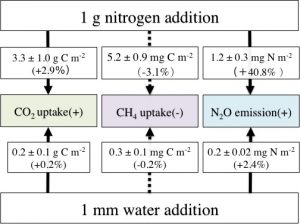
Congratulations to Lihua Zhang, a visiting professor in our lab, for her new publication in the Science of the Total Environment.
Nitrogen and water are two important factors influencing GHG (primarily CO2 – carbon dioxide; CH4 – methane, and N2O – nitrous oxide) fluxes in semiarid grasslands. However, the interactive effects of nitrogen and water on GHG fluxes remain elusive. A 3-year (2010 − 2012) manipulative experiment was conducted to investigate the individual and interactive effects of nitrogen and water additions on GHG fluxes during growing seasons (May to September) in a semiarid grassland in Northern China. Accumulated throughout growing seasons, nitrogen input stimulated CO2 uptake by 3.3 ± 1.0 g C m− 2 (g N)− 1, enhanced N2O emission by 1.2 ± 0.3 mg N m− 2 (g N)− 1, and decreased CH4 uptake by 5.2 ± 0.9 mg N m− 2 (g N)− 1; water amendment stimulated CO2 uptake by 0.2 ± 0.1 g C m− 2 (mm H2O)− 1 and N2O emission by 0.2 ± 0.02 mg N m− 2 (mm H2O)− 1, decreased CH4 uptake by 0.3 ± 0.1 mg C m− 2 (mm H2O)− 1. A synergistic effect between nitrogen and water was found on N2O flux in normal year while the additive effects of nitrogen and water additions were found on CH4 and CO2 uptakes during all experiment years, and on N2O emission in dry years. The nitrogen addition had stronger impacts than water amendment on stimulating CH4 uptake in the normal year, while water was the dominant factor affecting CH4 uptake in dry years. For N2O emission, the N-stimulating impact was stronger in un-watered than in watered plots, and the water-stimulating impact was stronger in non-fertilized than in fertilized treatments in dry years. The interactive impacts of nitrogen and water additions on GHG fluxes advance our understanding of GHG fluxes in responses to multiple environmental factors. This data source could be valuable for validating ecosystem models in simulating GHG fluxes in a multiple factors environment.
http://www.sciencedirect.com/science/article/pii/S0048969716324172

